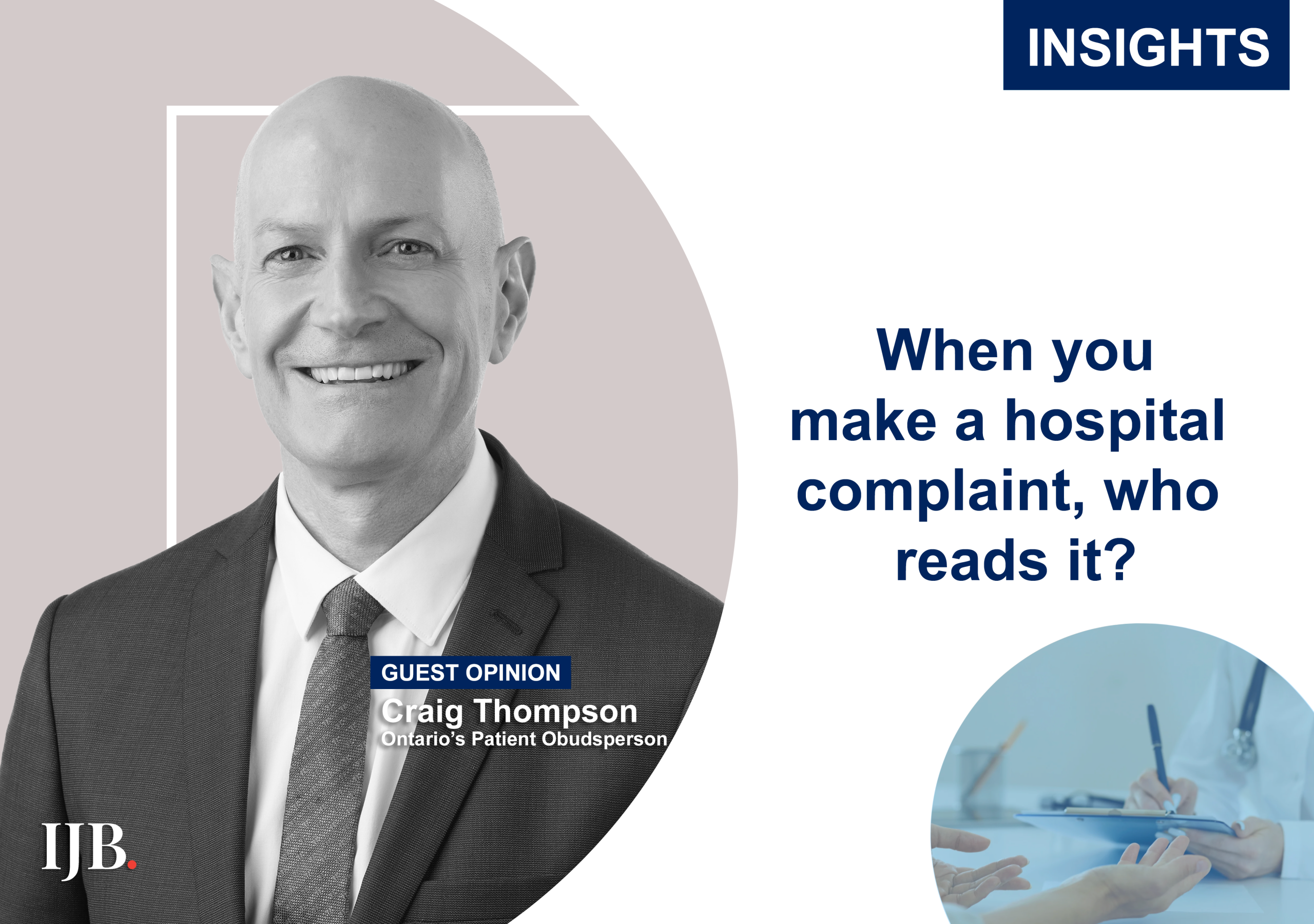

Craig Thompson is Ontario’s Patient Ombudsman. Serving as a bridge between patients and the province’s health care organizations, he offers us an inside look at patient experiences and how they drive meaningful healthcare improvements.
Every year, my office, the Patient Ombudsman, receives more than 4,000 complaints from patients, long-term care residents and their caregivers about negative experiences in Ontario’s health care system.
We’ve heard from patients who, after being referred to the emergency department by their primary care doctor, left without being seen after hours-long waits. We’ve heard from people who put their trust in clinicians during sensitive procedures, only to be treated with a lack of care and respect. We’ve heard from grieving families having to retell the story of their loved one’s cultural practices not being respected when they died. The details of those complaints are as unique as the individuals making them – no two are alike. That’s why it’s so important we listen to the full story so that we understand exactly what went wrong and where there are opportunities to make things right.
But these examples are just the tip of the iceberg—the truth is, patients and their families rarely complain.
Patients and caregivers are inherently vulnerable. They often fear raising concerns could affect their current care or create barriers to future care. It takes a lot of courage to tell someone that you’re dissatisfied with how things have turned out. Patients and caregivers can find it challenging to navigate complaint mechanisms, are confused by medical jargon, or don’t want to relive painful experiences. Even if they complain, there’s no guarantee that the provider will be open to criticism or that anything will change.
While my office has a strict jurisdictional mandate, people’s experiences often involve multiple settings and sectors. Their complaints offer a unique opportunity to learn about our systemic failings and pursue improvements.
Health care organizations, dealing with a reduced and stressed workforce, often feel complaints are a source of unfair criticism. But I see complaints in a different light—when people share their story, we get much-needed information that can help us understand what went wrong, and what can be done to improve experiences for everyone.
For example, in 2023, my office investigated a situation where a youth with the developmental age of a five-year-old was discharged from a paediatric hospital’s mental health unit. Their parent had told staff they did not feel safe bringing the youth home without support. The youth was referred to the Children’s Aid Society (CAS) where they were left in a waiting room without prescriptions or instructions for their care.
While disheartening, I am encouraged that this investigation led to significant improvements. Based on our recommendations, the hospital and CAS are looking to change discharge pathways and develop an escalation process to ensure children’s needs are met. Staff have undergone training, and the hospital now tracks data on patients who require alternate level of care to help inform its decision-making.
It may seem surprising, but I believe health care organizations should make it easier to complain and should look for ways to learn from those complaints. Just like the health care system, complaint processes can be complicated; organizations tailor complaint processes to fit community needs. Even so, we offer valuable guidance.
At a minimum, health organizations must:
- Let patients and caregivers know how to make a complaint
- Document the nature of the complaint and identify how it was addressed
- Tell patients and caregivers the outcome of the review
- Inform complainants about options should they remain unsatisfied
Generally, we need to know who is making a complaint so that we can follow-up with the health organization. When we share data and stories about complaints publicly, we maintain confidentiality. But it’s not unusual for my office to hear from people who want to share their story anonymously. This information is valuable and helps us track trends or highlight an area of particular concern. We also have whistleblower protections in place when staff, health care providers or volunteers feel there’s something we should know.
Making things right when complaints aren’t resolved
As with most ombuds offices, my team typically reviews complaints after the organization involved has had a chance to resolve the concern. When we receive a complaint, we work with the complainant and the health organization to come to a fair and reasonable resolution. We are impartial, unbiased and do not advocate for any one party over another; we advocate for fairness: fair processes, fair decisions and fair treatment.
We also look for deeper insights by rigorously recording and analyzing complaints. Our rich data allows us to identify issues of significant public interest that affect the entire health system. Through our formal investigations, my office has made more than 100 recommendations4 that have resulted in hospitals revising policies to better address communication, fees, and discharge processes; making trauma-informed training mandatory; and implementing technology to better track patient complaints and audit the hospital’s response.
The silver lining to complaints is better experiences for patients and providers where everyone feels respected and are active participants in the delivery of care. Simply said, better experiences mean better health care.
To learn more about our investigation into ignored complaints click here.